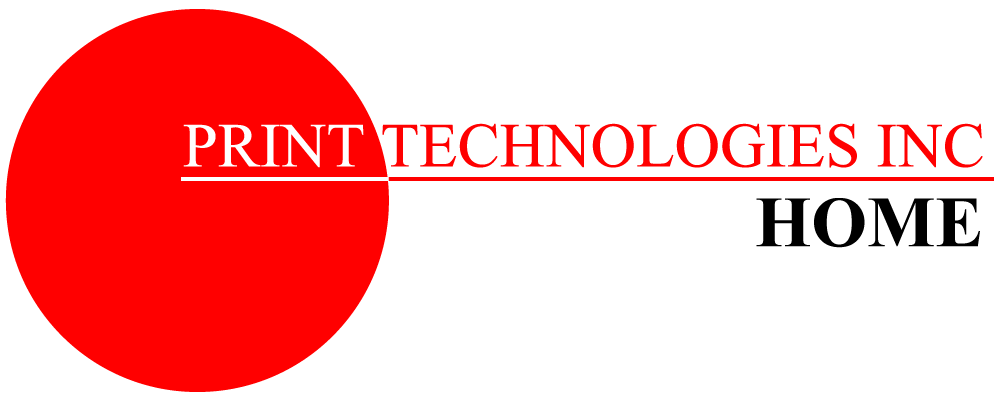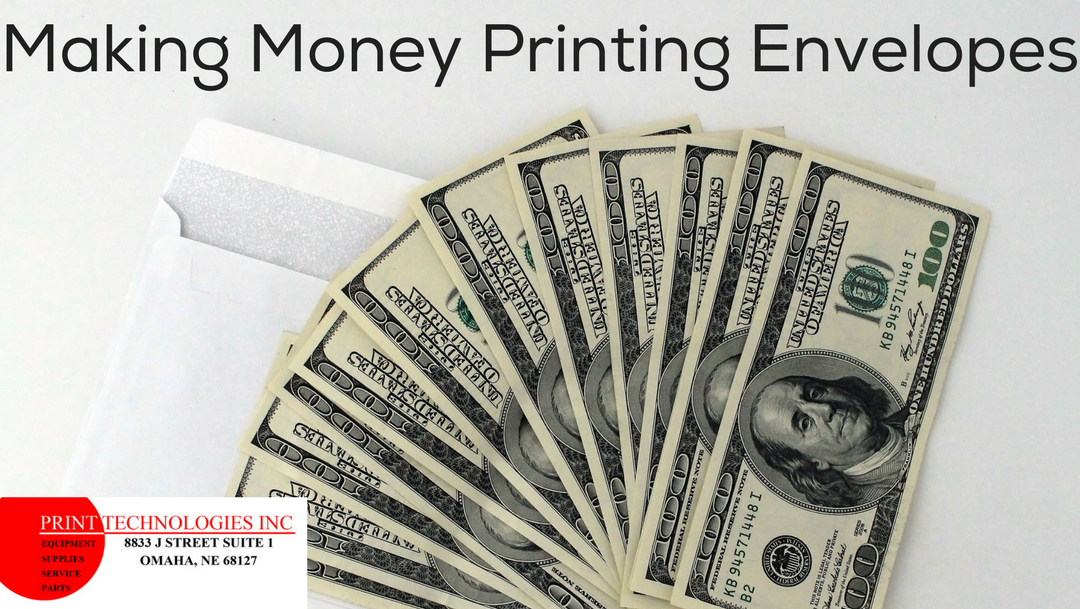There are several different ways that the industry prints envelopes. When it comes to choosing the best method for printing envelopes, there are certain criteria that need to be considered. A few of these would be costs, quality, length of run, size of envelope, a need for variable data, turnaround time, and the list goes on.
I will be going over many of these methods of printing envelopes along with the advantages and disadvantages of each of the methods. We won’t be going over older technologies that are no longer viable for envelope printing, but we will be focusing on all current technologies still being used in the printing industry today.
The following information is my opinion and is based on 40 years in the Printing Industry. My service background goes through liquid copiers, mimeographs, spirit duplicators, offset, digital duplicators, laser based copiers and printers, liquid and direct plate makers and ink jet technologies. I could go into more detail to describe each of the processes, but the purpose here is to give a broad overview of each of the current technologies used in the envelope printing business, their advantages, and their disadvantages. I hope this helps you in your future understanding of each of the technologies.
MIMEOGRAPH (commonly called Digital Duplicators)
Mimeograph equipment has been in existence for over 100 years. The technology is still being manufactured to this day.
Mimeographs use a stencil, which is a perforated paper product, that is wrapped around an ink drum cylinder. When the cylinder is rotated, the ink penetrates the perforations and is pressed onto the paper, developing the image.
PROS
Mimeographs use a low-cost liquid ink. You can purchase separate drums in order to print standard and sometimes, special spot colors. A new stencil is used for every job at a cost under thirty cents. These stencils are typically good for around 5,000 copies. Modern day mimeographs automatically make, install and eject the stencils. On older mimeographs, the stencils were made off line and manually placed and removed from the mimeograph. Mimeographs operate in excess of six to ten thousand copies per hour. The feed system on most mimeographs is adaptable from paper to postcards and envelopes. The mimeograph technology is very good for the Thermography industry or what is typically called “Raised Lettering”. The purchase price of a modern day mimeograph is twenty to thirty thousand dollars. Mimeographs have an extremely long service life, exceeding millions.
CONS
Lower printed resolution. Even though mimeograph manufacturers claim 1200 to 2400 dpi, that is the resolution printed on the stencil/master. The mimeograph technology is based upon a liquid ink that must penetrate the stencil to be applied to the paper stock. The paper is usually a porous paper which once the ink hits the paper, you will get what the industry calls dot gain. So a true 2400 dpi resolution on the printed stock is not attainable. If you use a coated stock, you will need a dryer unit and even with the newer inks, the quality results are less than satisfactory and an inline dryer is a must. Mimeographs usually run one spot color at a time, although two color units are available. You can run stock back through a second and third time, but registration is too poor for tight registration. You will need a separate drum for each of the spot colors that you wish to run. Because of the cost of the stencil, short runs of under 25 or 30, are not cost effective. Mimeographs cannot print variable data.
Mimeographs are best at runs of 30 to ten thousand, where high quality is not the prime concern.
OFFSET PRESS
PROS
We will start with sheet fed offset presses. The strength of the offset press in feeding envelopes is first, quality, then cost per copy, and then the ability to color match. Offset presses can print a variety of stocks, from porous to coated. A typical small sheet fed press will have the ability to print two colors at once, although there are those sheet fed presses that can print four colors at once. As in the copier/printer world, offset presses are built in different sizes and capabilities. The small presses are typically used for the smaller run jobs, 500 to 3,000 to 4,000. Longer runs can be escalated up to Jet Presses. The jet presses can print up to 60,000 envelopes per hour, and up to four colors at once. The next levels of offset presses is a flat sheet large press and web press. These presses can run envelopes just like a normal print job and then a converter is used to die cut and glue the envelopes into the finished product. Offset presses have a very long service life into the hundreds of millions. Except for the Jet presses, the offset press can and is used for printing other print jobs, which keeps the overall costs lower.
As you can see, there are a variety of offset presses to choose from.
CONS
Offset presses need a trained operator. Offset presses cannot do variable data printing. (Yes, there are exceptions on the large presses by putting an ink jet in line with the offset). Offset presses must have plate makers to produce the offset plates. Plate makers can be inline or offline. Because of the plate costs and initial set up costs, offset presses are not efficient under 500 envelopes on the smaller presses, and higher on the Jet presses and large offsets with converters. The overall cost of a new offset system can be $50,000 up into the millions. There are used systems that can be purchased for under $15,000 but are generally used for one and two color envelopes and usually only competitive under three to four thousand envelopes. The Jet press has a higher price tag, but are more efficient at higher print numbers, usually over four to five thousand envelopes and into the millions. Bottom line is that offset presses are a more expensive technology to get into but that doesn’t mean that you can’t make money with an offset press. Everything is based on the type of jobs and the run length of those jobs.
Offsets are best with high quality, multi color, static data envelopes, 500 to millions of envelopes.
XEROGRAPHIC COPIER/PRINTERS
PROS
We will call them printers to save space. Printers are user-friendly. The general population can operate them with ease. Whether you need one copy or thousands of copies, they can and do run one color and four color process envelopes. The quality on printers has improved over the past 30 years to be very close to offset printing. In most cases, the end user can’t tell the difference. Only the offset purest will be able to tell the difference. Printers come in all sizes for all applications. You can pick the size, speed, and quality to closely match your needs. Printers can do full-color envelopes while printing variable data, further enhancing the printed envelope. This saves time and money where envelopes need to be addressed.
CONS
Printers are very maintenance intense. They need constant service to keep them in top condition to output optimum quality. Service life of a printer is low compared to mimeographs and offset presses. Service life can be based upon monthly volumes or terminal volume of the printer. Some of the low end printers are self service, for the most part. For the larger printers, it is usually prudent that you maintain a service agreement, which can significantly raise your cost per copy. Down time on printers is much higher than either offset of mimeograph to the point in critical environments, it is necessary to have a 100% backup for the printer, further increasing costs. The feed system on most printers is not envelope friendly. All printers, to some extent can feed envelopes. The problem arises when the paper hopper holds only a few envelopes at a time, not good for production. The second problem with envelopes and printers is that when an envelope travels through a printer, it must bend around guide chutes that are pinching the envelope going in and coming out. When you bend two separate sheets of paper, such as an envelope, one sheet is traveling further than the other which is one of the causes of the wrinkling. The next problem is that most current printers have too great a distance between rollers to handle the smaller envelopes. This may or may not be a problem, based upon your needs. Cost of ownership of a printer is very difficult to grasp. There are literally hundreds of service contracts on the market. This could open up another paper that could go on forever.
The bottom line is that printers are best at short runs (1 to several thousands), multi color envelopes with variable data. Costs to print on envelopes can vary from under a penny for black only and can be anywhere from four to five cents up to over ten cents, based on the contracted price. There are printers that are designed to be self service friendly. The ability to be self serviceable, the overall cost to print envelopes can be under two cents per envelope.
INK JET
PRO
This is a fast changing section of the business. Ink jets are fast, seven thousand plus per hour, and have a very low cost when printing envelopes . Envelope return address printing can be under one fourth of a cent. If you are using the right paper, ink jets can print great quality. Ink jets can print four color process and spot color with variable data. Ink jets need very little maintenance and are user friendly to service. Service life of ink jets is very high, with the fact they do not have many moving parts. The current ink jets on the market have feed systems that can handle a variety of stocks including envelopes and card stocks. I am aware of only two types of envelope inkjet printers on the market. One printer is based upon the mimeograph design and feed system and the other is strictly a feeder and ink jet head system.
CONS
Ink jets need a stock that is compatible with ink jet. If you do not use an ink jet stock, your images will be flat, soft color and usually shift in color. The type of paper your envelopes are made of has a huge effect on the print quality output. Not all stocks are ink jet compatible and the ink will not dry easily, even when using a dryer. There are two types of ink jet printers on the market. One has a pile feeder and the other has a bottom feeder. The pile feeder feeds like a mimeograph and the bottom feeder uses an older drop in style feeder. This feeder can be temperamental and takes a little getting used to.
Ink jets are great when printing four color and spot color envelopes with variable data as long as the quality meets the expectation on the stock that you are using. Ink jets are one of the least expensive methods of printing envelopes.
WHAT’S NEXT
I hope this brief overview of different methods of printing envelopes has been helpful. Stay tuned to our future articles when we will go into more detail on envelope printer systems and we will start to compare these technologies. Which one or two will fit your needs the best?
Have questions?
Contact us at pat@printechnologies.com to get the conversation started!

